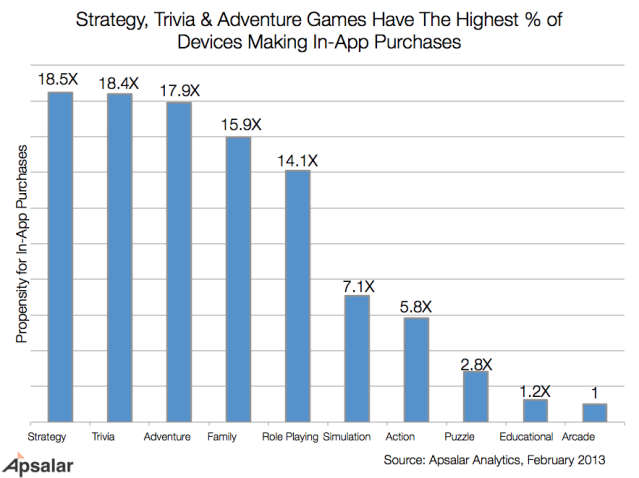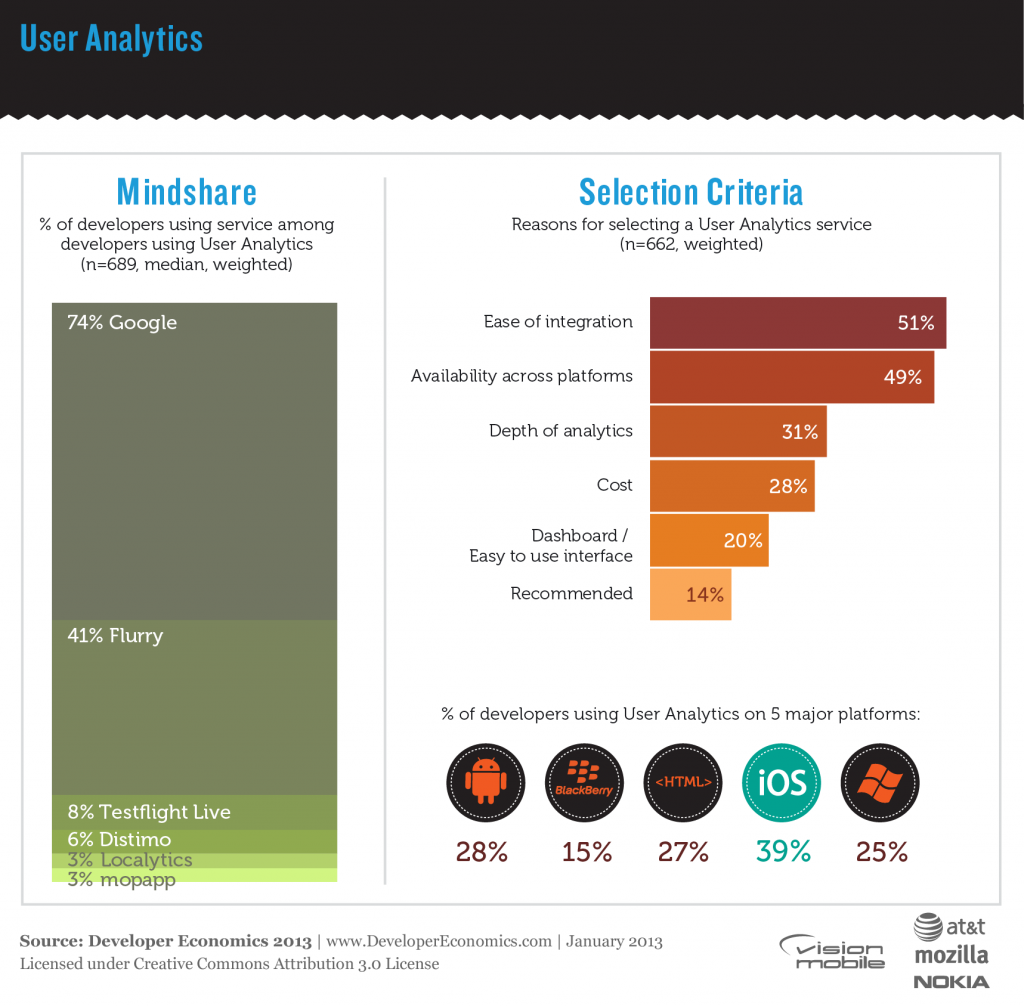In our Developer Economics 2012 survey, we asked developers about their biggest challenges. Here we discuss six of them, with some basic tips on what to do about them. The challenges are split between marketing and post-launch app and user management. The three biggest marketing challenges were: keeping users engaged, targeting the right users and identifying the right revenue model. The three biggest post-launch challenges were: Tracking bugs and errors, getting users to review your app and updating applications in the field.
Keeping users engaged
Keeping users engaged was the challenge cited most often overall, by 39% of developers, irrespective of primary platform. This is consistent with data from analytics firm Flurry, who report that user engagement falls sharply over time, with only 24% of consumers continuing to use an app after three months from download. “Developers must focus on tracking user engagement & usage patterns rather than just on downloads” notes Jai Jaisimha, founder of Open Mobile Solutions, a brand-to-developer matchmaking service.
There are many techniques for improving user engagement and retention. Social buttons like Follow or Like, especially when integrated with social networks are known to increase engagement. “‘Follow is the most common social feature used by our users” notes Yiannis Varelas, co-founder of Weendy, a weather app for surfers, with 6,500 monthly active users and 80% retention rate (in May last year). Where direct social integration doesn’t make sense, push notifications are another tool to help keep users engaged.
Gamification is another retention technique that rewards users for achievements (e.g. FourSquare-style badges) or for inviting other users (e.g. for each user you invite to Dropbox, you get another 250MB free storage space). Moreover, Tom Hume, founder of Future Platforms, argues that developers need to fundamentally rethink user retention. “To improve retention, developers need to build up value for the user that increases with usage. A natural way to do this is to build in a history of usage data – for example in the Nike Plus the value and stickiness of the application increases as more data is recorded in the application”.
Targeting the right users
The second most oft-cited challenge is targeting and getting through to the right users – mostly because existing app stores offer little in the way of user targeting. App stores, for example, provide no means for developers to reach existing customers or gain information about them. The only way developers can target users via app stores is via coarse-grained methods based on app categorisation or keyword selection.
Consequently, we found that developers using app stores are more concerned about targeting (39%) and engagement (46%) than developers using most other distribution channels. The situation in carrier portals is even worse: around 55% of developers using them are challenged by targeting and engagement.
Customer information, as with any business, is a key source of competitive advantage. As such, app stores have little incentive to share customer data with app developers. Apple has done so in part, after considerable pressure, but only to Newsstand publishers, and only where customers opt in. There’s more to it than just control: app store owners are loath to jeopardise user privacy contracts, lest their platforms become marketing “wild wests.”
The inaccessibility of customer information will likely remain a thorny issue, and one that hampers developers’ marketing potential. For the moment, it generates a flurry of innovation, as evidenced by the proliferation of in-app and external app marketing channels. However, seeing as this will remain a pain point, there may be opportunities for app stores to differentiate, if they manage to balance their priorities against those of developers – as Apple arguably has with Newsstand publishers. In the meantime, app developers would be wise not to wait for the app stores to fix this. Try to reach the right users for your app wherever they are currently, via blogs, forums and more traditional media. Arrange cross-promotions with similar but complementary apps. Experiment with alternate discovery solutions and find out what works for your app.
Identifying the right revenue model
Developers were becoming increasingly confused (36%) about which revenue model to use. There are over 10 revenue models to choose from and no guarantees as to which revenue model will work best in the long run in terms of reach vs. monetisation. Moreover, the revenue model needs to be optimised to the platform and app category. The decision should also take into account factors such as customer paying propensity (which varies across platforms), competitor pricing and positioning (which varies by app category). For example, paid downloads are extremely unpopular on Android, whilst apps aimed at children often need to use that model, since parents are very uncomfortable with in-app purchase or advertising based models for apps their children are using. User needs should also come into perspective when considering
your pricing strategy. “You may only need one Facebook, sports or weather app, but you will want to play many games. Mobile games are like movies – users are always looking for the latest one,” notes Markus Kassulke, CEO at Germany-based HandyGames.
Overall, we found that pay-per download was the revenue model used most frequently, by 34% of developers irrespective of platform, followed closely by advertising, which was used by 33% of developers. Wherever possible, the best advice we can give for now is to try some sort of freemium or virtual goods model using in-app purchases. The growth of in-app purchase revenues across iOS and Android is significantly outpacing paid downloads.
Tracking bugs and errors
Tracking bugs and errors was, by far, the most frequent post-launch headache, as reported by 38% of developers in our survey – and particularly so for WP7 developers. There is no direct feedback channel between users and developers, and no out-of-box
means to monitor the performance of an app. App reviews work and feel more like post-mortems, rather than a live feedback tool. As a result, developers will often find out what’s wrong with their app too late, through users’ negative feedback. “Our biggest headache after launch is the lack of a two-way communication channel with our users” notes Hong Wu, Director of Android Engineering at Peel, makers of a personalised TV guide app.
The first line of defence here is to remove as many errors as possible before launch, both through good engineering practices during development and extensive beta testing. The second line of defense comes in the form of crash analytics and bug tracking services. These services track app errors by monitoring crashes and reporting the type of error, platform, device and environmental variables like location, time and transaction flow. As such, they can provide useful insights, helping find and fix errors before they drive users away.
Updating applications in the field
Updating apps was highlighted as a challenge by 25% of developers irrespective of platform. Interestingly, the difference in the update process between iOS and Android has no impact on developers’ attitudes – as both iOS and Android have their own update challenges. On iOS the process requires full certification and approval by Apple, plus explicit opt-in by the user. On Android, the update process can be automatic and near-instantaneous. This however requires that users opt-in for automatic updates for specific applications. In effect, these challenges with the update process on both iOS and Android increase the average application “age” and escalate both code maintenance and customer support costs for developers.
One solution to this is to have the app check for the availability of a newer version at launch. Although it may not be possible to have the application download the update, it could prompt the user to do so. Another option here is to track application versions via analytics and send push notifications to users with sufficiently old versions, highlighting the benefits of updating to the latest version.
Getting users to review apps
Last but not least, another frequent post-launch challenge was getting users to review apps, reported by 30% of developers irrespective of platform. At the same time, there have been some success stories of apps boosting their review numbers, usually by nagging users after they have used the app for some time. For example, to solicit reviews, DrawSomething shows a motivating alert where “Rate 5 stars!” and “Remind me later” are the only two options, wrapped in a friendly pop-up box. The example shows that the runaway success of DrawSomething was more science than luck. However, DrawSomething’s grossing ranking was declining in the run-up to the all-important Christmas sales season, showing that even successful and well funded apps with highly social components can struggle with our first challenge – keeping users engaged in the face of all the other shiny new offerings in the app stores.
















